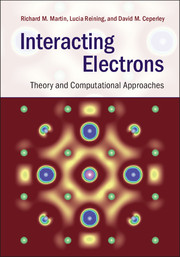Book contents
- Frontmatter
- Dedication
- Contents
- Preface
- Acknowledgments
- Notation
- Part I Interacting electrons: beyond the independent-particle picture
- Part II Foundations of theory for many-body systems
- 4 Mean fields and auxiliary systems
- 5 Correlation functions
- 6 Many-body wavefunctions
- 7 Particles and quasi-particles
- 8 Functionals in many-particle physics
- Part III Many-body Green's function methods
- Part IV Stochastic methods
- Part V Appendices
- References
- Index
6 - Many-body wavefunctions
from Part II - Foundations of theory for many-body systems
Published online by Cambridge University Press: 05 June 2016
- Frontmatter
- Dedication
- Contents
- Preface
- Acknowledgments
- Notation
- Part I Interacting electrons: beyond the independent-particle picture
- Part II Foundations of theory for many-body systems
- 4 Mean fields and auxiliary systems
- 5 Correlation functions
- 6 Many-body wavefunctions
- 7 Particles and quasi-particles
- 8 Functionals in many-particle physics
- Part III Many-body Green's function methods
- Part IV Stochastic methods
- Part V Appendices
- References
- Index
Summary
In no wave function of the type (1) [product of single determinants for each spin] is there a statistical correlation between the positions of the electrons with antiparallel spin. The purpose of the aforementioned generalization of (1) is to allow for such correlations. This will lead to an improvement of the wave function and, therefore, to a lowering of the energy value.
E. Wigner, Phys. Rev. 46, 1002 (1934)Summary
Although the exact many-body wavefunction cannot be written down in general, we do know of some of its properties. For example, there are differences between the wavefunctions of insulators and metals and the cusp condition gives the behavior as any two charges approach each other. In this chapter we also discuss approximate wavefunctions, ways to judge their accuracy and how to include electronic correlation. Examples of many-body wavefunctions are the Slater–Jastrow (pair product) wavefunction and its generalization to pairing and backflow wavefunctions.
In other places in this book, we argue that it is not necessary to look at the many-body wavefunctions explicitly because they are unwieldy; the one- and two-body correlation functions discussed in Ch. 5 are sufficient to determine the energy and give information on the excitation spectra. However, these correlation functions do not always contain all information of interest. In principle, the ground-state energy of a many-electron system is a functional of the density, but the very derivation of the theorem invokes the many-body wavefunction, as expressed explicitly in Eq. (4.16). The effects of antisymmetry are manifest in the correlation functions, but antisymmetry is most simply viewed as a property of the wavefunction; electronic correlation is fundamentally a result of properties of the many-body wavefunction.
Studying many-body wavefunctions provides a very useful, different point of view of many-body physics from the approaches based on correlation functions. Many of the most important discoveries in physics have come about by understanding the nature of wavefunctions, such as the Laughlin wavefunction for the fractional quantum Hall effect, the BCS wavefunction for superconductors, p-wave pairing in superfluid 3He, and the Heitler– London approach for molecular binding. The role of Berry's phases has brought out the importance of the phase of the wavefunction in determining properties of quantum systems. This has led to new understanding of the classification of insulators, metals, superconductors, vortices, and other states of condensed matter.
Information
- Type
- Chapter
- Information
- Interacting ElectronsTheory and Computational Approaches, pp. 122 - 143Publisher: Cambridge University PressPrint publication year: 2016
